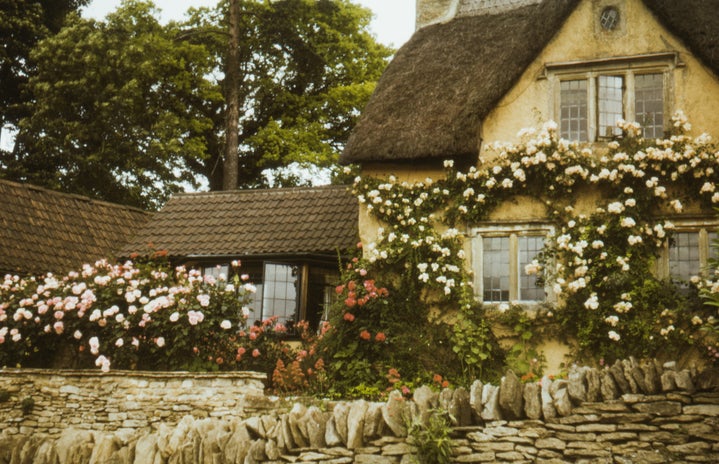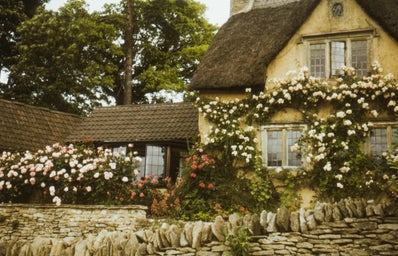This article is written by a student writer from the Her Campus at UWB chapter.
What is “cottagecore?”
Cottagecore is an aesthetic or lifestyle characterized by its rustic decor, usage of handicrafts, and rural living. Often, those interested in cottagecore long for a simpler, more natural lifestyle away from the hustle and bustle of cities and ever-evolving technologies.
Why should you incorporate more cottagecore elements into your life?
In the modern age, our society prioritizes speed, productivity, and efficiency over actual enjoyment and personal satisfaction. The cottagecore lifestyle often calls for people to slow down and be more in the moment. It’s hard to feel the fast-paced nature of modern life when you’re churning butter! Slowing down to enjoy the world around you can provide a sense of peace and calm.
Top 10 Simple Ways to Incorporate Cottagecore Elements into Your Life
- Get an apron. Whether you make or buy your apron, wearing an apron can remind you of the hands-on nature of life! I personally own and love this apron because of its giant pockets and lack of need to tie it. An apron is also a great way to prevent your clothes from getting soiled when working on at-home projects. I wear my apron when in the kitchen, in the garden, or when doing art projects. After getting a few holes in my apron, I ended up embroidering over those holes with cute flowers!
- Wear more comfortable clothes. The cottagecore lifestyle often comes with the feeling of warmth and comfort, so consider adapting that idea into your wardrobe! For example, instead of tight jeans, try a long skirt or dress. Instead of a t-shirt, try a linen tunic. These comfortable and loose clothes are especially nice in the summer since they allow for good ventilation to cool down your body!
- Bake bread. Bread is a staple in many homes across the globe, even if the kind of bread varies from culture to culture. Buying store-bought staple foods is actually a lot more expensive than making them yourself. Of course, in buying store-bought items, you’re able to save time, and sometimes that’s the deciding factor in what gets bought at the grocery store. Things like milk or eggs require someone to have farm animals, which most certainly is not an accessible option for many. Traditional bread, on the other hand, is actually really easy to make and is cost-effective! I like using recipes like this from Spruce Eats to make my bread.
- Plant a garden. Or, at least plant a few plants! In full-scale cottagecore, one would likely have a large garden that allows them to be mostly self-sufficient. However, for many, that’s an intimidating or inaccessible idea. If you have the land, a garden is great. If you don’t, consider trying out container gardening! One of my favorite containers to use is the EarthBox. Container systems allow for gardening in small spaces like apartments or houses without yards. They do need to be outside, so sometimes even this isn’t the right solution for small-space gardeners. If you’re tight on space or can’t have plants outdoors, growing herbs on a windowsill is another simple way to incorporate growing your own food into busy city life.
- Spend more time outdoors. That’s right! Just go outside more often! With modern life relying more and more on technology, both jobs and our free time have migrated firmly indoors. Try taking a break outside if you can. My favorite thing to do when I’m overwhelmed is to lie down on some grass. It’s also nice to walk barefoot outdoors. It’s a very grounding feeling!
- Shop at thrift stores. Cottagecore aesthetics often reflect previous eras of style, especially the mid-1900s. While buying reproduction or vintage items from retailers is fine, it’s usually better to shop second-hand. Not only does this help eliminate clothing waste from fast fashion, but it’s also much less expensive than traditional stores!
- Learn more. To clarify, find kinds of information you enjoy learning and pursue them! I personally love learning about permaculture, which is a kind of gardening that is usually self-sufficient and is good for the environment. As a gardener, it’s also pretty easy to take care of, and it takes care of you by providing all sorts of bounty!
- Wear more bandanas. I’m a huge proponent of bandanas. They’re great for so many things! I use them to carry items or hold back my hair. They also come in tons of different designs and are easy to stash away in a bag or pocket. I originally learned 100 ways to use bandanas for first aid back in Girl Scouts, but there are also tons of other ways to use bandanas. Here’s a link from the Girl Scouts of Western Ohio that outlines 35 different ways to use a bandana, including links to how-to articles for more complicated ideas.
- Eat slowly. By slowing down, it helps your body properly digest your food and allows you to taste what you’re eating better. Being conscious of what you’re eating and how can also give you space to reflect on your own food traditions. The Slow Food Movement, started in 1989, was founded to help protect local food cultures and traditions around the world. Life of convenience often erases eons-old cultures, and it’s no different with food. Take your time and enjoy what you’re eating!
- Try more handicrafts. Handicrafts are simply defined as things you can make with your hands. Or, rather, things you can make without automation or large amounts of power tools. A few examples include knitting, cooking, and woodworking. Making something by hand can give you a sense of accomplishment as well as help you learn how to use what’s provided to make something great. It can also be cost-effective, especially if you don’t need to invest in expensive tools. Instead of thrift shopping, you could even make your own clothes or accessories!


